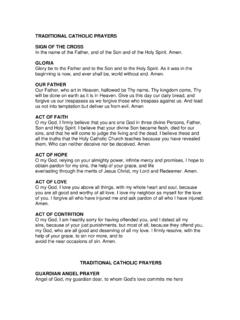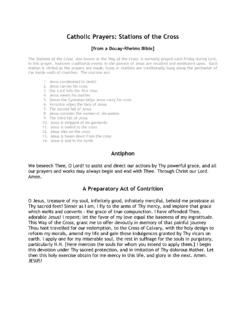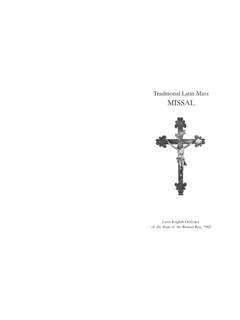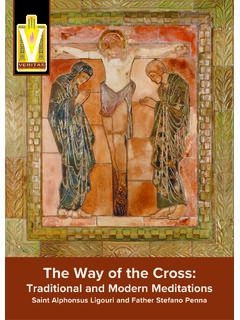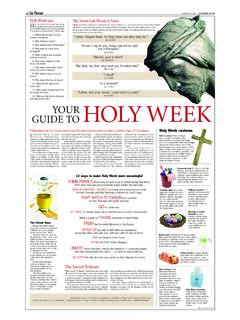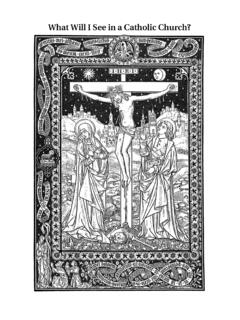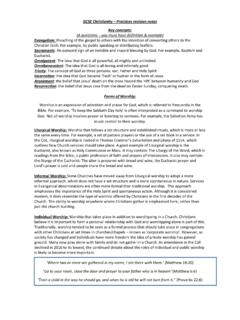Transcription of 10. The New Rite of Ordination - vaticancatholic.com
1 11210. The New Rite of Ordination Michael Davies: .. every prayer in the traditional rite [of Ordination ] which stated specifically the essential role of a priest as a man ordained to offer propitiatory sacrifice for the living and dead has been removed [from the New Rite of Paul VI]. In most cases these were the precise prayers removed by the Protestant reformers, or if not precisely the same there are clear parallels. 1 In addition to having invalidating changes made to the Mass, the Devil knew that he had to tamper with the rite of Ordination so that the priests of the New Church would be invalid as well. The New Rite of Holy Orders (bishops, priests, deacons) was approved and imposed by Paul VI on June 18, 1968. The following information is crucial for all Catholics to know, since it concerns the validity of essentially every priest ordained within the diocesan structure since approximately 1968; and consequently, it concerns the validity of countless confessions, indult Masses, etc.
2 On Nov. 30, 1947, Pope Pius XII issued an apostolic Constitution called Sacramentum Ordinis. In this Constitution, Pope Pius XII declared, in virtue of his supreme apostolic authority, the words that are necessary for a valid Ordination to the priesthood. traditional FORM FOR Ordination OF PRIESTS Pope Pius XII, Sacramentum Ordinis, Nov. 30, 1947: But regarding the matter and form in the conferring of every order, by Our same supreme apostolic authority We decree and establish the following: .. In the Ordination of priests, the matter is the first imposition of the bishop s hands which is done in But the form [of Ordination ] consists of the words of the preface of which the following are essential and so required for validity: Grant, we beseech You, Almighty Father, to these Your servants, the dignity of the Priesthood (presbyterii dignitatem); renew the spirit of holiness within them, so that they may hold from You, O God, the office of the second rank in Your service and by the example of their behavior afford a pattern of holy living.
3 2 THE NEW FORM FOR Ordination OF PRIESTS Here is the form of the New Rite of Ordination of Priests: Grant, we beseech You, Almighty Father, to these Your servants, the dignity of the Priesthood; renew within them the spirit of holiness. May they hold from You, the office of the second rank in Your service and by the example of their behavior afford a pattern of holy living. 3 The difference between the two forms is that the Latin word ut (which means so that ) has been omitted in the New Rite. This may seem insignificant, but in Sacramentum Ordinis Pius XII declared that this word was essential for validity. Further, the omission of so that gives rise to a relaxation of the naming of the sacramental effect (conferring the office of the second rank). In other words, removing so that presupposes an Ordination which has already taken place, but is not taking place as the words are being pronounced.
4 The New Rite of Ordination 113 Since the new rite purports to be the Roman Rite, this removal of ut (so that) renders the new rite of questionable validity. However, there is a much bigger problem which proves that the New Rite is invalid. THE BIGGEST PROBLEM WITH THE NEW RITE OF Ordination IS NOT THE FORM, BUT THE SURROUNDING CEREMONIES WHICH HAVE BEEN REMOVED The change to the essential form is not the only problem with the New Rite of Ordination promulgated by Paul VI. The following points are just as significant because the Sacrament of Order, although instituted by Our Lord Jesus Christ, was not instituted by Our Lord with a specific sacramental form unlike the Sacraments of the Eucharist and Baptism, which were instituted by Our Lord with a specific sacramental form so that the form of words in Ordination is given its meaning and significance by the surrounding rite and ceremonies.
5 In his famous Bull, Apostolicae Curae, Sept. 13, 1896, Pope Leo XIII solemnly declared that Anglican Ordinations are invalid. This means that the Anglican sect doesn t have valid priests or bishops. Pope Leo XIII, Apostolicae Curae, Sept. 13, 1896: .. of Our own motion and certain knowledge We pronounce and declare that Ordinations carried out according to the Anglican rite have been and are absolutely null and utterly void. 4 In making this solemn pronouncement, it must be understood that Pope Leo XIII was not making Anglican Ordinations invalid, but rather he was declaring that they were invalid due to defects in the rite. But what were those defects or problems which Leo XIII saw with the Anglican Rite, which contributed to its invalidity? Pope Leo XIII, Apostolicae Curae, Sept.
6 13, 1896: When anyone has rightly and seriously made use of the due form and the matter requisite for effecting or conferring the sacrament he is considered by that very fact to do what the Church does. On this principle rests the doctrine that a sacrament is truly conferred by the ministry of one who is a heretic or unbaptized, provided the Catholic rite be employed. On the other hand, if the rite be changed, with the manifest intention of introducing another rite not approved by the Church, and of rejecting what the Church does, and what by the institution of Christ belongs to the nature of the sacrament, then it is clear that not only is the necessary intention wanting to the sacrament, but that the intention is adverse to and destructive of the sacrament. 5 Here we see Pope Leo XIII teaching that if a minister uses the Catholic rite in conferring the Sacrament of Order, with the correct matter and form, he is considered for that very reason to have intended to do what the Church does intending to do what the Church does is necessary for the validity of any sacrament.
7 On the other hand, he tells us, if the rite is changed with the manifest intention of introducing a new rite not approved by the Church, and of rejecting what the Church does, then the intention is not only insufficient, but is destructive of the Sacrament. And what were the things that Pope Leo XIII described as showing the destructive intention of the Anglican rite of Ordination ? The New Rite of Ordination 114 Pope Leo XIII, Apostolicae Curae, Sept. 13, 1896: For, to put aside other reasons which show this to be insufficient for the purpose in the Anglican rite, let this argument suffice for all: from them has been deliberately removed whatever sets forth the dignity and office of the priesthood in the Catholic rite. That form consequently cannot be considered apt or sufficient for the sacrament which omits what it ought essentially to signify.
8 6 Pope Leo XIII, Apostolicae Curae, Sept. 13, 1896: So it comes to pass that, as the Sacrament of Orders and the true sacerdotium [sacrificing priesthood] of Christ were utterly eliminated from the Anglican rite, and hence the sacerdotium [priesthood] is in no wise conferred truly and validly in the Episcopal consecration of the same rite, for the like reason, therefore, the Episcopate can in no wise be truly and validly conferred by it; and this the more so because among the first duties of the Episcopate is that of ordaining ministers for the Holy Eucharist and sacrifice. 7 Pope Leo XIII, Apostolicae Curae, Sept. 13, 1896: Being fully cognizant of the necessary connection between faith and worship, between the law of believing and the law of praying, under a pretext of returning to the primitive form, they corrupted the liturgical order in many ways to suit the errors of the reformers.
9 For this reason in the whole Ordinal not only is there no clear mention of the sacrifice, of consecration, of the sacerdotium [sacrificing priesthood], but, as we have just stated, every trace of these things, which had been in such prayers of the Catholic rite as they had not entirely rejected, was deliberately removed and struck out. In this way the native character or spirit as it is called of the Ordinal clearly manifests itself. Hence, if vitiated in its origin it was wholly insufficient to confer Orders, it was impossible that in the course of time it could become sufficient since no change had taken place. 8 Michael Davies: As the previous section made clear, every prayer in the traditional rite [of Ordination ] which stated specifically the essential role of a priest as a man ordained to offer propitiatory sacrifice for the living and dead has been removed [from the New Rite of Paul VI].
10 In most cases these were the precise prayers removed by the Protestant reformers, or if not precisely the same there are clear parallels. 9 Michael Davies: ..there is not one mandatory prayer in the new rite of Ordination itself which makes clear that the essence of the Catholic priesthood is the conferral of the powers to offer the sacrifice of the Mass and to absolve men of their sins, and that the sacrament imparts a character which differentiates a priest not simply in degree but in Dear reader, these things described above by Pope Leo XIII as the downfall of the Anglican Rite of Ordination the systematic removal of every reference to the sacrifice of the Mass, consecration and the true sacrificing priesthood are exactly the things that occurred in the New Rite of Ordination promulgated by Paul VI!


